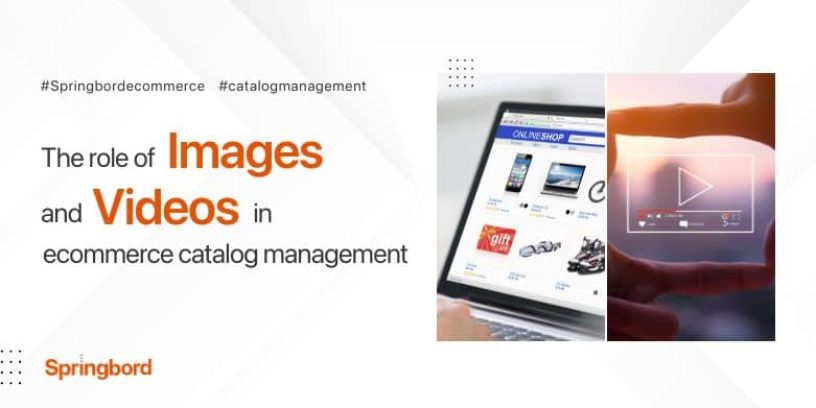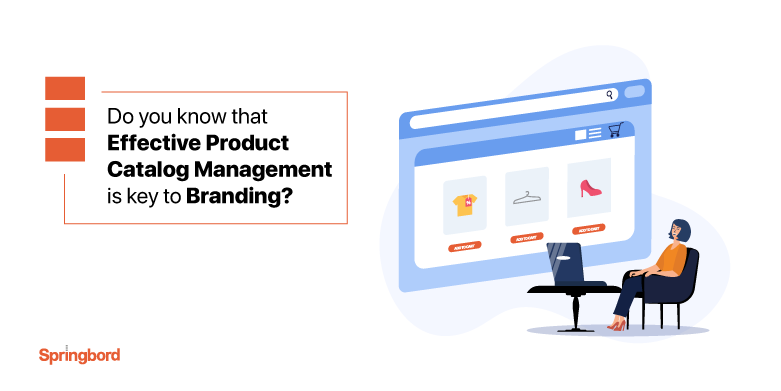 Read time 3 min
Read time 3 minAs an ecommerce service provider, Springbord understands the importance of visual content in online shopping. In this blog, we’ll explore the role of images and videos in ecommerce catalog management and how they can help you attract and retain customers.
At Springbord, we understand the importance of effectively managing your ecommerce catalog to drive sales and increase revenue. One key aspect of catalog management that often gets overlooked is the role of images and videos. In this article, we’ll explore the impact that high-quality visuals can have on your ecommerce catalog and provide actionable tips to help you optimize your catalog for success.
Why Images and Videos Matter in Ecommerce Catalog Management
In the world of ecommerce, product images, and videos is the closest thing customers have to physically interact with a product. High-quality visuals help customers visualize the product and understand its features and benefits, which can increase their likelihood of making a purchase.
Additionally, including images and videos in your catalog can help improve the overall user experience of your website. Customers are more likely to engage with your site and spend more time browsing when they have access to high-quality visuals that showcase your products in the best possible light.
Tips for Optimizing Your Catalog with Images and Videos
Now that we’ve established the importance of including high-quality visuals in your ecommerce catalog, let’s dive into some tips for optimizing your catalog with images and videos.
1. Use High-Quality Images and Videos
First and foremost, it’s essential to use high-quality visuals that accurately represent your products. Blurry, pixelated images or videos that don’t showcase your product in the best possible light can actually hurt your sales and turn customers away.
Investing in high-quality photography and videography can go a long way in improving your catalog’s visual appeal and increasing sales.
2. Optimize for Speed
High-quality images are essential, but they must also be optimized for load time. Websites that load slowly due to the presence of numerous large media files tend to have lower search engine rankings and provide a worse user experience overall.
To avoid this, make sure to compress your images and videos without sacrificing quality. You can also use lazy loading techniques to improve the speed of your catalog.
3. Provide Multiple Views and Angles
To help customers visualize your products, provide multiple views and angles. This can help customers understand the product’s features and benefits and improve their overall experience.
Including interactive 360-degree product views or videos that showcase the product from different angles can be a great way to provide customers with a more comprehensive understanding of the product.
4. Include Alt Text and Descriptions
Alt text and descriptions are essential for improving the accessibility and search engine optimization of your catalog. The alt text describes the image or video to screen readers, while descriptions provide context for the product.
Make sure to include relevant keywords in your alt text and descriptions to improve your catalog’s search engine visibility.
5. Use Video to Showcase Product Features
In addition to images, video can be a powerful tool for showcasing your product’s features and benefits. Consider creating product demo videos that highlight key features or explain how to use the product.
By including videos in your catalog, you can increase engagement and provide customers with a more immersive experience.
6. Use Product Demos
The features and benefits of a product can be best demonstrated through a demonstration. By showing customers how a product works, they can get a better understanding of what it does and how it can benefit them.
7. Use How-To Videos
How-to videos can be used to show customers how to use a product or how to perform a specific task. These videos can be particularly helpful for complex products that may require some explanation.
8. Keep Videos Short and Sweet
Attention spans are short on the internet, so businesses should keep their videos short and to the point. A good rule of thumb is to keep videos under two minutes in length.
Conclusion
In today’s competitive ecommerce landscape, effectively managing your catalog is essential for driving sales and increasing revenue. By optimizing your catalog with high-quality images and videos, you can improve the user experience of your website and increase your chances of making a sale.
At Springbord, we specialize in helping businesses optimize their ecommerce catalogs for success.
Contact us today to learn more about our catalog management services and how we can help you drive sales and grow your business.







